-
The N6NB rover
page
Ever since the advent
of the Maidenhead grid square multiplier system in amateur radio, "roving"
in VHF/UHF/microwave radio contests has been popular in North America.
Under the Maidenhead plan (so named because
it was developed at a conference in Maidenhead, England), the world is
divided into geographic units one degree of latitude high and two degrees
of longitude wide that are identified by four-digit codes such as FN20
(in the U.S. northeast) or DM04 (in Southern California). The system
also provides for six-, eight- or even 10-digit codes that can be used
to pinpoint a station's location more precisely. The original idea
was to facilitate calculations of the distance between two stations for
contests with distance-based scoring. That scoring system is widely
used in Europe, but in North America the four-digit grid squares are used
as multipliers in most contests. The total number of points for two-way
contacts is multiplied by the number of different grid squares worked.
Because many grid squares have little or no
local activity (especially on the UHF and microwave bands), the Maidenhead
system encouraged roving stations to travel to various grid squares during
VHF/UHF radio contests. What they do is akin to a road rally with
amateur radio equipment aboard, and it has enormous appeal to people who
might not otherwise operate a VHF contest.
Some amateurs spend months planning an itinerary that
will take them on a 1200-mile trek through 20 or more grid squares during
a contest. And rovers have dramatically increased the activity level
in sparsely populated areas, while providing otherwise unavailable multipliers
to fixed contestants. Starting when the grid square multiplier system
went into effect in the 1980s, N6NB and many others have been roving.
The photos here show many of our early and more recent rover installations.
Although it's very popular, roving has been surprisingly
controversial--for several reasons. For one, questions have been
raised about rover operating practices. Many rovers attempt to visit
as many grid squares as possible, a practice encouraged by the ARRL rules
(which award an extra multiplier for each grid square visited during the
contest period). That forces rovers to keep moving, never venturing
far off the major highways and rarely stopping to operate with high, directional
antennas. If they are to visit as many grid squares as possible,
rovers have no choice but to leave rare grid squares quickly and
go on to grid squares that are not rare. Some fixed operators
say this makes it more difficult to contact rovers in the rare and distant
grid squares that they visit, defeating one purpose of roving. There
have also been perennial complaints about two other practices: (1)
"captive" rovers seeking out only one or a few stations while they're in
each grid square and making little effort to be available to the general
amateur community; and (2) "grid circling" in which two or more rovers
travel together and work each other as they move around a point where four
grids converge. Some object to rovers working each other in
several grid squares even if they don't engage in "grid circling."
Two rovers will often travel together and work each other only once in
a given grid square (as opposed to working each other multiple times as
first one then the other of them circles around a grid convergence).
When rovers travel together, that has been called "pack roving."
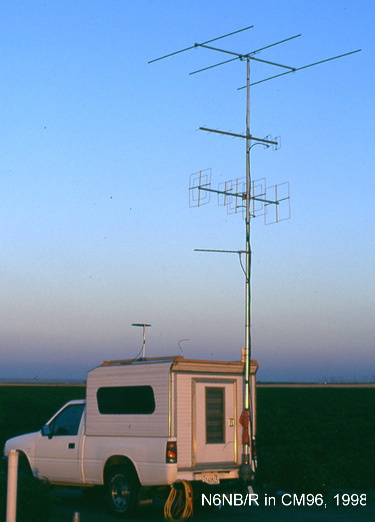 The rover scoring system has also been controversial. The system
has been revised four times, and some rovers are still not pleased with
the result. Originally, rover stations scored their activity
in each grid square separately. For a time QST magazine listed
all of these separate scores and didn't separate out rovers from single
operators. The separate scores were very low compared to single operator
scores, even if all of a station's scores were added up. Rovers demanded
better treatment. The response was a rover scoring system, introduced
in 1991, that some have called "megascoring." The contacts and multipliers
from all locations were aggregated and the sums were then multiplied, producing
much larger total scores. Even though that produced an enormous increase
in rover activity, the higher scores stirred controversy, too.
The rover scoring system has also been controversial. The system
has been revised four times, and some rovers are still not pleased with
the result. Originally, rover stations scored their activity
in each grid square separately. For a time QST magazine listed
all of these separate scores and didn't separate out rovers from single
operators. The separate scores were very low compared to single operator
scores, even if all of a station's scores were added up. Rovers demanded
better treatment. The response was a rover scoring system, introduced
in 1991, that some have called "megascoring." The contacts and multipliers
from all locations were aggregated and the sums were then multiplied, producing
much larger total scores. Even though that produced an enormous increase
in rover activity, the higher scores stirred controversy, too.
A review of rover participation in VHF contests
in the three years before and after "megascoring" was introduced illustrates
just how much the recognition in QST and the new scoring opportunities
increased activity. In June, 1988, eight (8) rovers submitted logs.
In September, 1988, there were 11 rover logs. In June, 1989, 21 rover
logs were submitted, with 15 submitted in September, 1989. In June,
1990, there were 20 rover logs, with 13 in September, 1990.
Then roving exploded, aided by the new scoring
system. In June, 1991, the first with "megascoring," there were 50
rover entries--more than double the number the previous June. In
September, 1991, there were 30 rover entries, a 50% increase from a year
earlier. In June, 1992, there were 64 rover entries--another big
increase. September, 1992, attracted 46 rover logs. In June,
1993, there were 63 rover logs, with 62 in September, 1993--another very
large increase.
Although roving was booming, some opposed the new
scoring system.
To dramatize what they saw as the unfairness of
that system, four amateurs (two father and son teams) in New England went
roving in the January, 1993 VHF contest in two vehicles, working each other
on nine bands as they circled around the point where four grid squares
came together. Then they did the same thing at another convergence
of four grid squares. When the contest was over, each of the four
had amassed one and a quarter million points: four people in two
vehicles had scored five million points. The highest fixed station
score in that contest was about 300,000 points. Then the four added
their scores with those of fixed stations in their radio club, the Hampden
County Radio Assn., creating a club aggregate score more than triple
that of the perennial winner, the Mt. Airy VHF Club in Philadelphia.
The Mt. Airy Pack Rats had won the club aggregate competition every year
for more than 30 years, but the rover scoring system ended that tradition.
Fixed stations simply could not compete. A further irony was that
the Rochester VHF Group, the perennial number two club in the January contest,
also topped the Pack Rats that year--but got upstaged by four guys in two
vehicles. RVG's long-sought triumph in the club competition was not
to be--until later. (As QST magazine pointed out, though,
RVG's club aggregate score was also boosted by rover scores.)
The high-scoring foursome (Stan Hilinski, KA1ZE, and his
son Kevin, NR1L, and Robert Cohen, K1CPJ, and his son Scott, KA1QAS) revolutionized
VHF rovering--and demonstrated what was possible. But because their
monster scores overwhelmed the traditional club competition, there was
an outcry for still another change in the scoring system, although many
rovers defended the "megascoring" system by arguing that it made the contests
a lot more fun and stimulated activity in many parts of the country.
The debate raged at club meetings and conventions, in petition-gathering
efforts and on the air.
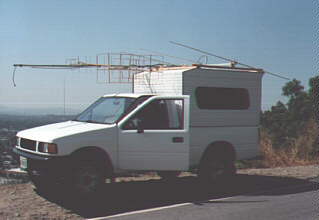 After several years, ARRL reached a compromise: rovers could continue
to aggregate their QSO points, but they could count each multiplier only
once--with a single additional multiplier for each grid square activated.
This resulted in rover scores somewhat more comparable to those attainable
by fixed stations. However, it became clear over the years that rovers
can still achieve high scores, especially when two or more rovers travel
together so they all can work the rare multipliers that they are handing
out to others. By roving in tandem and sometimes circling a four-grid
convergence, rovers can amass scores that only the top fixed single-operator
stations can match. This has enabled some rovers to achieve high
scores even in sparsely populated areas where there may be no fixed stations.
After several years, ARRL reached a compromise: rovers could continue
to aggregate their QSO points, but they could count each multiplier only
once--with a single additional multiplier for each grid square activated.
This resulted in rover scores somewhat more comparable to those attainable
by fixed stations. However, it became clear over the years that rovers
can still achieve high scores, especially when two or more rovers travel
together so they all can work the rare multipliers that they are handing
out to others. By roving in tandem and sometimes circling a four-grid
convergence, rovers can amass scores that only the top fixed single-operator
stations can match. This has enabled some rovers to achieve high
scores even in sparsely populated areas where there may be no fixed stations.
After the rules were changed a second time,
just about everyone thought the scoring record set by KA1ZE's team would
hold up indefinitely, but the mark only stood for six years.
Operating under the revised scoring
system, a team formed out of the legendary Grid Pirates multioperator contest
group, signing N3IQ/R, scored 1,391,942 points in the 1999 VHF SS.
Operators ND3F and WD8ISK (later K8ISK and then W8ZN) roved in tandem with
K8GP/R, operated by K6LEW and KA3QPG, who posted a score of 827,372 points.
The two teams visited 15 grid squares and worked each other on an incredible
12 bands--and then set out to work everyone else they could hear in the
activity-rich northeast corridor. But their record, too, was broken after
only six years--rovers were achieving higher and higher scores.
Many other teams of rovers from coast to coast
have achieved good scores by roving in tandem. At least seven of
the top 10 rovers in 2004 VHF SS traveled with another rover. In
recent years rovers in Eastern Washington, Western Washington, Southern
California, the upper midwest, East Texas/Louisiana, Rochester, NY and
the high plains have all scored 250K or more (often much more) by roving
together.
This led to still more controversy and another
major revision of the rover rules. In 2008, ARRL added two more categories
to the rover competition. In the unlimited category, rovers
may work each other freely and may even "rove" by operating at two or more
fixed stations in different grid squares during a contest weekend.
Large groups may also operate together in a bus, for instance, in the unlimited
category because the normal limit of two licensed operators per vehicle
does not apply. However, unlimited rovers may not participate in
the club competition--their scores cannot be counted toward a club's aggregate
score. In the classic rover category, rovers may only work
any one other rover a maximum of 100 times and may not operate from a fixed
station because the rules require that the rover vehicle transport the
entire station, including antennas. A third
limited rover
category was added in 2008. This is a category for rovers who operate
on no more than four bands (any four bands at first) with a maximum
power that is the same as in the single operator low-power category (i.e.,
200 watts on six and two meters). In 2009, the limited category was
restricted to the lowest four bands in any VHF/UHF contest.
Like classic rovers, limited rovers are allowed to work any other one rover
a maximum of 100 times. Classic and limited rovers are allowed to
participate in the club competition.
The three-category rover system remains controversial,
with some contending that rovers can still achieve excessively high scores
by roving together. Some have called for still more changes in the
rover rules--even a return to the original scoring system where activity
in each grid square was scored separately. It remains to be seen
how that might affect overall contest activity--and whether the resulting
low scores might cause roving to revert to its original status as primarily
a means by which some fixed stations could boost their scores.
Whatever the pros and cons of the scoring system,
rover operating is still popular in VHF contests.
Roving
coast to coast
The photos on this page show many different rover
stations built by N6NB. Building them was a logical outgrowth of
building portable contest stations in campers during the 1970s and 1980s.
The first portable station, the so-called "Cabover Kilowatt," appeared
on the cover of QST magazine in 1971. The first dedicated
rover, built around an Isuzu 4X4, was used with good success in the 1990s.
Its main innovation was a method of setting up relatively high directional
antennas quickly. It took not more than two minutes to go to the
operating position with the antenna stack upright (top photo) from the
travel position (photo at right, above). The mast was secured to
a rotator on the rear bumper of the truck with one bolt. When the
bolt was removed, the mast tilted forward into a cradle on the truck.
Then a coaxial cable and another bolt were removed to slide the 6-meter
antenna off the mast and into a rooftop cradle. For optional
high-power operation, starting a gasoline generator took another minute
or two.
This installation worked well for someone who wanted
to go to just a few grid squares and spend considerable time operating
in each one, perhaps from a superior off-the-highway location. That
allowed more people to contact a few rare grid squares, but it made it
impractical to visit 15 or 20 grid squares during a contest. In the
June, 1998 VHF contest, the N6NB/N6MU team had the top score on the west
coast, but we only visited eight grid squares.
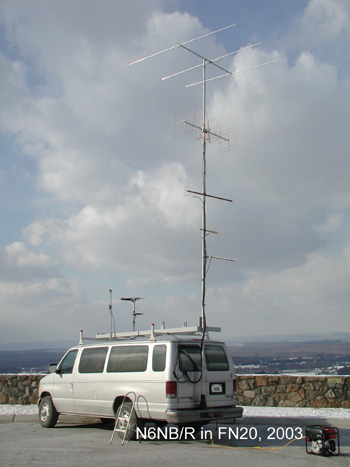 The second rover station, used during the early and mid-2000s, utilized
a Ford E350 15-passenger Supervan with all but the front seats removed.
Its antenna system was similar to the one on the Isuzu but with a longer
mast to take advantage of the greater length of the van. That permitted
excellent separation between antennas for various bands, minimizing interaction.
This rover station made its debut during the 2003 January VHF SS contest
on
the east coast. The van was driven from California to the northeast
and back just for the contest--a 6,500-mile trip that may rank as the longest
roving expedition ever in total miles driven to rove in a VHF contest.
In the photo here, the van is shown at an overlook on Interstate 80 near
Hackettstown in western New Jersey (FN20). Was it worth a 6,500-mile
trip? Any dedicated amateur radio contester knows the answer to that
question! It was also a sentimental journey--N6NB/1 on Mt. Equinox,
VT, set national scoring records in the June and September VHF contests
as a single operator in 1979-1980.
The second rover station, used during the early and mid-2000s, utilized
a Ford E350 15-passenger Supervan with all but the front seats removed.
Its antenna system was similar to the one on the Isuzu but with a longer
mast to take advantage of the greater length of the van. That permitted
excellent separation between antennas for various bands, minimizing interaction.
This rover station made its debut during the 2003 January VHF SS contest
on
the east coast. The van was driven from California to the northeast
and back just for the contest--a 6,500-mile trip that may rank as the longest
roving expedition ever in total miles driven to rove in a VHF contest.
In the photo here, the van is shown at an overlook on Interstate 80 near
Hackettstown in western New Jersey (FN20). Was it worth a 6,500-mile
trip? Any dedicated amateur radio contester knows the answer to that
question! It was also a sentimental journey--N6NB/1 on Mt. Equinox,
VT, set national scoring records in the June and September VHF contests
as a single operator in 1979-1980.
The E350 van shown in these photos was replaced
in 2008 by a new E350, which was configured similarly. The new van
appears in some of the later photos.
The photos immediately below show the N6NB/N6MU
tandem roving team in the September 2003 VHF contest, the first of many
contest expeditions by a growing group of rovers, many of them members
of the Southern California Contest Club. In 2003, one 10-band station
was installed in the Ford van and another 10-band station was installed
in an SUV. Later that year a third 10-band station was built for
use in several different vehicles..
Further down this page there are photos of
the first three-rover operation in January, 2004. It produced a combined
score of more than three million points, with N6MI/R, N6MU/R and N6NB/R
each topping a million points. There are also photos of the June,
2004 "high plains expedition," during which three 10-band stations roved
through 20 grid squares ranging from Midland, TX to the Nebraska border,
with N6NB setting a new June record of 1.29 million points. Further
down there are photos from the January, 2005 contest, when N6NB/R (operating
with W6XD), N6ZZ/R (with N2IC) and N6MU/R (with K2MM) visited 22 grid squares
in New Mexico and west Texas, scoring more than two million points each
for another record. Altogether, N6NB/R activated 52 grid squares
from coast to coast between January, 2003 and January, 2005.
As the rover building-boom continued, the N6NB rover
fleet grew to eleven (11) different 10-band rover stations, most of them
housed in large toolboxes that could be mounted on a rotor atop a roof
rack on any SUV. There is a separate page on this website describing
the toolbox stations. As the rover capability
grew, the Southern California Contest Club began competing in the ARRL
club aggregate competition and winning club gavels--something that no west
coast club had done before.
September
(2003) photos...
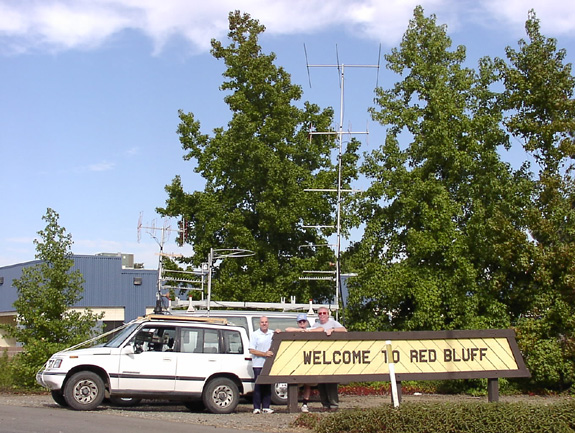
N6NB, N6MU and sports car rally driver Rob Hughes (left to right) pose
in CN80 with the two rover vehicles used in September, 2003. Having
a seasoned rally driver along made a huge difference in our pace.
N6NB/R and N6MU/R finished first and second nationally. Rob later
became KG6TOA.
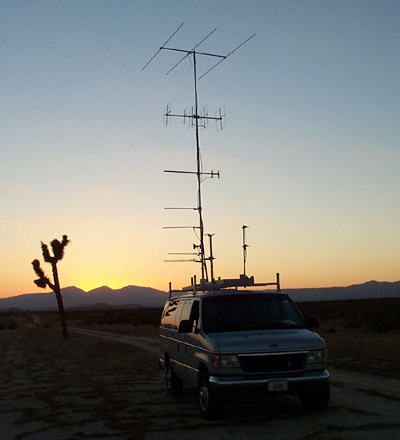 In this photo, taken by Rob Hughes (KG6TOA), the N6NB rover van is silhouetted
against a desert sunset in DM15, with the Tehachapi Mountains in the background.
N6NB's non-portable contest station was on the mountain ridge just to the
left of the van.
In this photo, taken by Rob Hughes (KG6TOA), the N6NB rover van is silhouetted
against a desert sunset in DM15, with the Tehachapi Mountains in the background.
N6NB's non-portable contest station was on the mountain ridge just to the
left of the van.
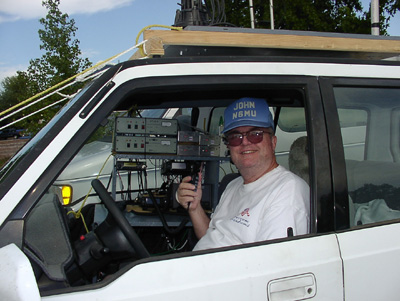
Here's John (N6MU) in his car, which was converted into a rover vehicle
at the eleventh hour before the 2003 September VHF contest. This
10-band station included two FT-100D transceivers, a 222 MHz FM transceiver
and transverters for 903, 1296, 2304, 3456, 5760 and 10368 GHz. On
the roof there are directional antennas on a G-800SA rotor for all bands
except six meters (where a loop is on a separate mast).
January
(2004) photos...
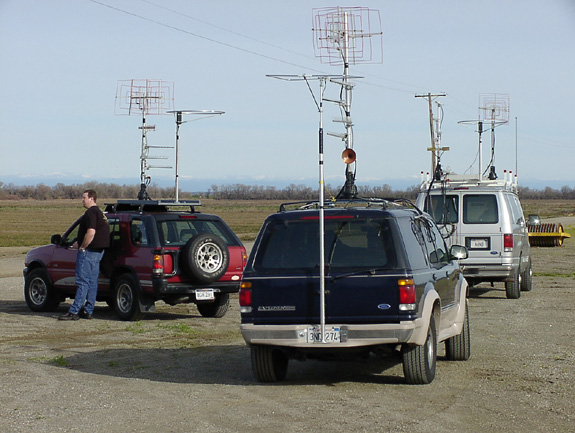
In January, 2004, the rover team grew to three 10-band stations, shown
here in CM99. At left is the Isuzu Rodeo used by N6MU/R, with driver
Bill Reese beside the car. In the foreground is the Ford Explorer
used by N6MI/R. Behind it is the van used by N6NB/R and KG6TOA.
Each of the three rover stations scored more than one million points in
the 2004 VHF Sweepstakes.
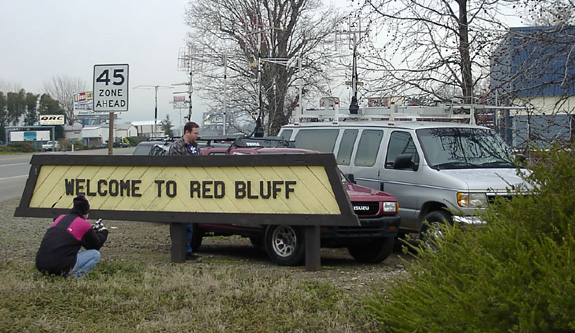
After the contest, the group did another photo session at the Red Bluff
sign in CN80, this time with three vehicles. In the foreground, Scott
Bovitz, N6MI, shoots video of the scene as Bill Reese stands beside the
Rodeo used for rover station #3.
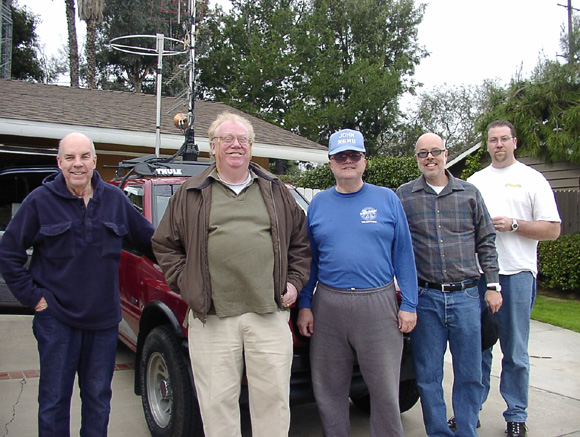
Before the contest began, the group posed at N6NB's house in Tustin, CA
(DM13). From left: Wayne Overbeck, N6NB; Rob Hughes, KG6TOA;
John Desloge, N6MU; J. Scott Bovitz, N6MI; and Bill Reese.
June
(2004) high plains expedition photos...
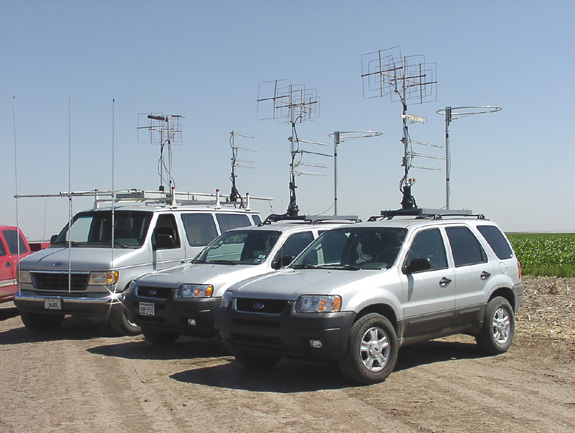
In June, 2004, we roved from Midland, TX northward through the high plains
to western Nebraska, activating 20 grid squares. Here the van and
two rented Ford Escapes are parked together for a photo opportunity beside
a cornfield near Dumas, TX at the convergence of grids DM85, DM86, DM95
and DM96. We drove the van from the Los Angeles area to Texas before
the contest and rented the two Escapes in Midland, outfitting them with
10-band rover stations that had been hauled from California in and on the
van. N6NB and KG6TOA roved in the van, while N6VI used the Escape
in the center and N6MU the Escape at right.
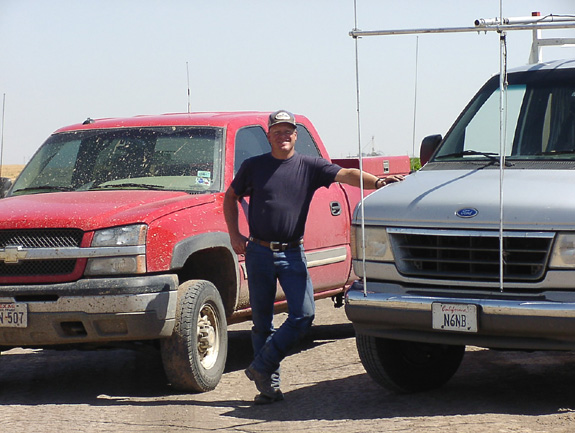
Rancher Brooks Brown, who owns about 1,000 acres at the DM85-DM86-DM95-DM96
convergence, stopped by to say hello. He was delightfully hospitable,
but he suggested we were pushing our luck by using three Fords for the
expedition. The red truck at left is his.
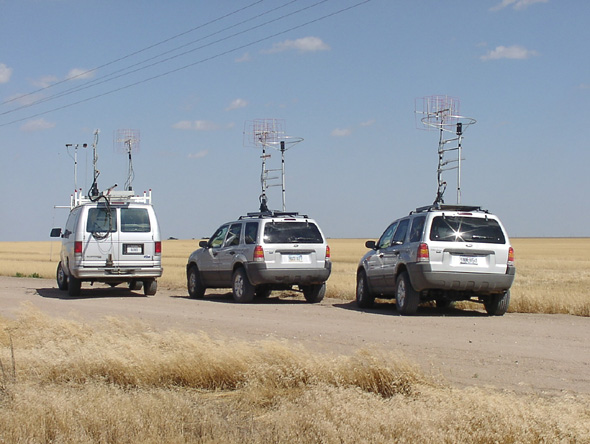
We stopped among amber waves of grain for this photo opportunity
near Jetmore, KS, at the convergence of grids DM97, DM98, EM07 and EM08.
The farm roads in the high plains turned out to be surprisingly good.
A few hours after this photo was taken, our three stations were in Nebraska
after a successful 800-mile run through 20 grid squares during the contest.
N6MU, N6NB and N6VI all had scores over a million points, unprecedented
for rovers in the June contest.
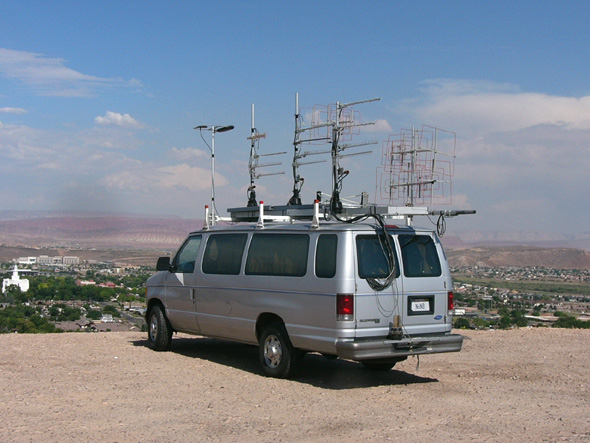
KG6TOA took this photo of the van on a hill overlooking St. George, Utah,
near the end of the 4,000 mile trip to the midwest and back. The
van is carrying three complete 10-band antenna systems, 12 transceivers,
15 microwave transverters and an assortment of amplifiers.
January,
2005: Three rovers, 6.5 megapoints
The January, 2005 VHF contest was a memorable
event for many participants. The northern and eastern states experienced
near-blizzard conditions, with impossibly high snow-induced noise levels.
Some rovers courageously went afield in this horrible weather, but the
scores of both fixed stations and rovers were understandably lower than
usual. We roved in New Mexico and West Texas and experienced surprisingly
good weather for January--no snow, only moderate winds, and clear skies
much of the time. We visited a total of 22 grid squares and traveled
1,000 miles during the contest, amassing three scores over two million
points--the first ever to exceed two megapoints in VHF SS. Here's
the breakdown:
Call
Qs Q pts Mult Score
N6NB/R (+W6XD) 2040
9098 242 2,201,716
N6ZZ/R (+N2IC) 1957
8943 242 2,164,206
N6MU/R (+K2MM) 1937
8900 242 2,153,800
These scores are directly attributable to the
talents of the seasoned contest operators who joined us for this venture.
It quickly became clear why they're so successful in HF contests.
One of the highlights was spanning some seemingly
impossible paths, working over high hills on 10 Ghz. Another was
working W5LCC 27 times from seven grid squares, including Qs on 1296 from
five grid squares. And we worked K5RHR 15 times (thanks for making
Lubbock and Albuquerque so workable, guys).
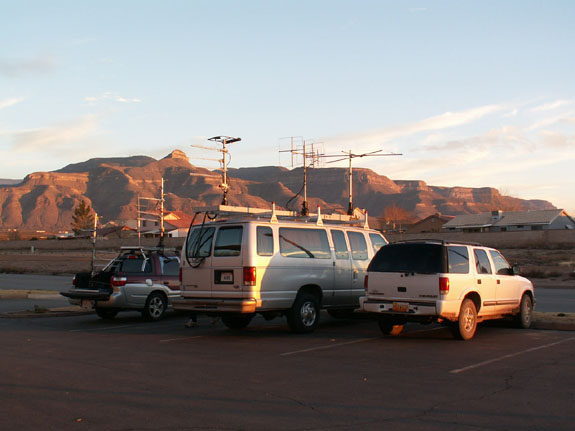
This photo was taken just after we arrived in Alamogordo, NM. N6ZZ's
Blazer had not yet been outfitted, but that would soon change.
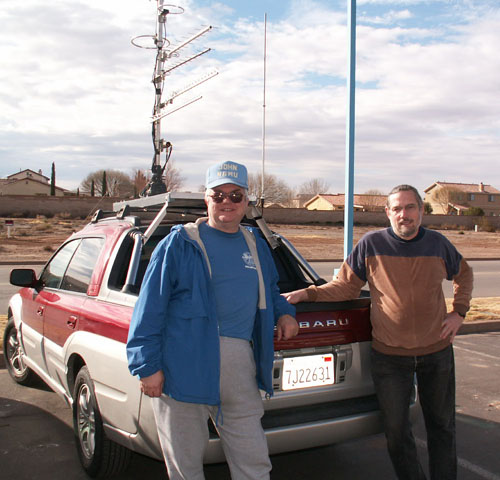
Here are N6MU (left) and K2MM ready to go on Saturday morning just
before the contest.
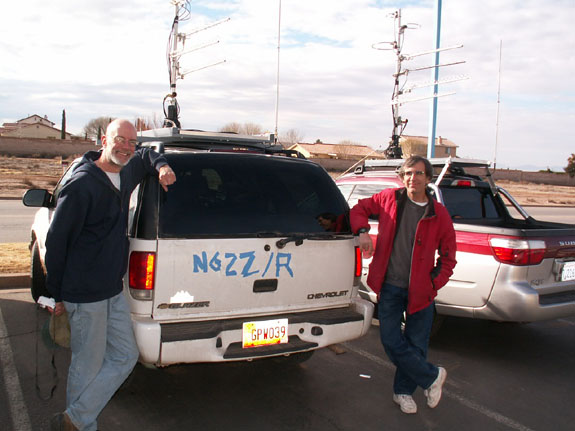
N6ZZ (left) and N2IC operated in Phil's Blazer, now outfitted with
antennas for 10 VHF+ bands.
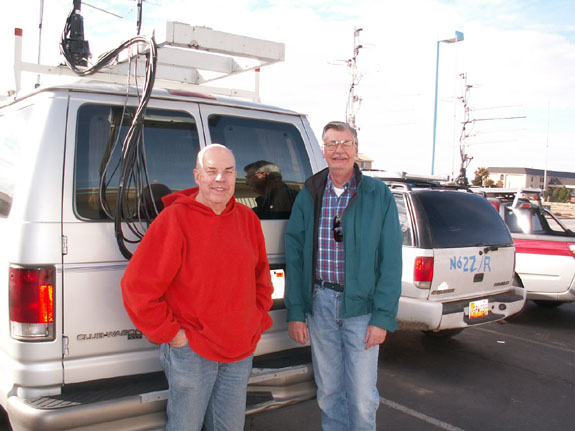
For N6NB (left) and W6XD, who operated in the van, this contest was notable
in another way: it marked the first time in 20 years that neither
of them was attending an ARRL Board of Directors meeting during the weekend
of the January VHF contest. Both had been there/done that and were
happy to leave that responsibility to two other contesters, N6AA, the new
Southwestern Division director, and AA7A, who served as vice director from
2005 until 2008.
January,
2006: Three megapoint-plus scores in two days, door to door
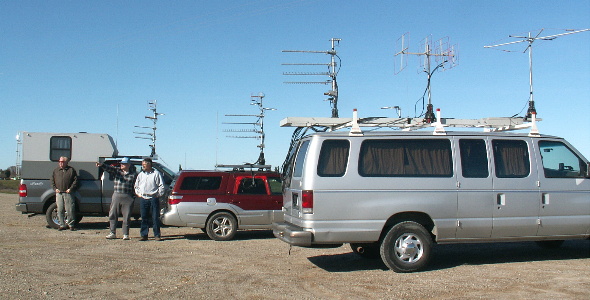
John Desloge, N6MU, points to the south toward Sacramento from CM99, the
northernmost point on the January, 2006 route followed by W6XD/R (operating
in the Ford van), N6MU/R (in the Subaru Baja) and K6VCR/R (in the Ford
F-150 4x4). With John are Rob Hughes, KG6TOA (left) and Hank Feilen
(right). Art Goddard, W6XD, made almost 400 random contacts with
other stations besides N6MU and K6VCR during the contest and had a total
score of nearly 1.2 megapoints. Both N6MU and K6VCR also made several
hundred random contacts and topped one megapoint, demonstrating what's
possible during a two-day expedition. The group started the contest
in Orange County, Calif. at 11 a.m. (PST) Saturday and arrived back about
1 a.m. Monday morning.
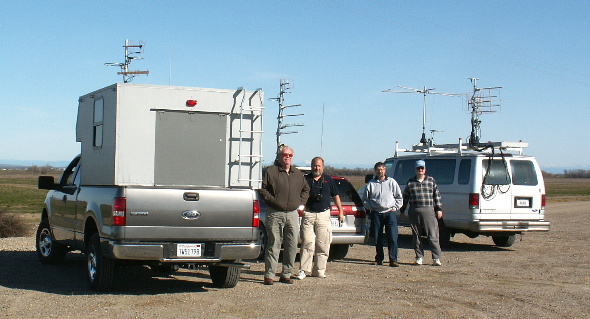
In this photo Rob (KG6TOA, left), Tom (K6VCR), Hank and John (N6MU) pose
during a break in CM99. Art (W6XD) didn't get into the picture because
he was still operating in the van. This picture was taken by N6NB
Sunday afternoon just before the group headed back south via Concord (CM87)
and several grids along the I-5 corridor.
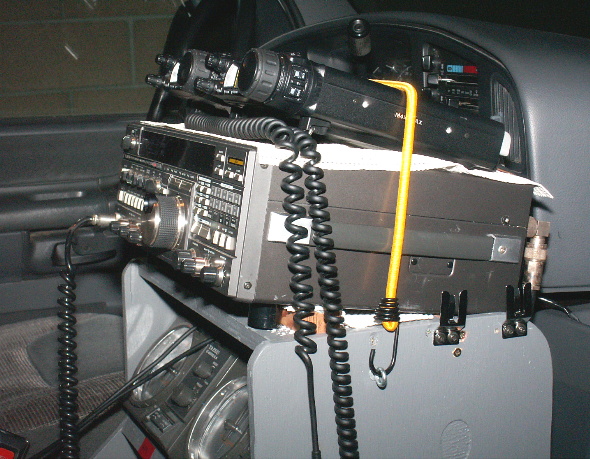
In addition to the original operating console in the rear of the Ford van,
a second console between the two front seats was added in January, 2006
so two operators could work simultaneously.
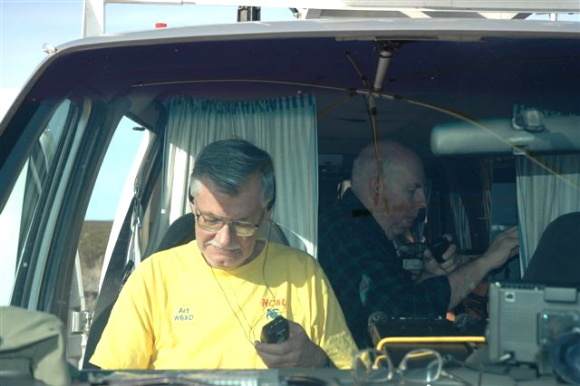
Using the two consoles, W6XD and N6NB operate at the Mojave convergence
(photo by K6VCR). Art became the field general and quarterback of
the roving group as it grew.
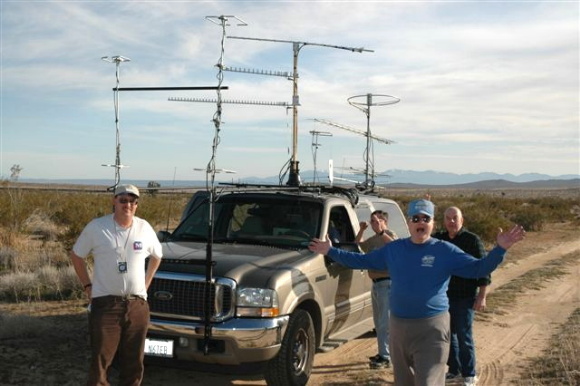
"Is this pack roving or what?" asks N6MU (in blue shirt) as KE6HPZ (left),
N6DN and N6NB gather around N6TEB's Ford Excursion in the Mojave Desert.
At the time, six 10-band rovers were all at the Mojave convergence (K6VCR/R,
N6DN/R, N6MU/R, N6RMJ/R, N6TEB/R and W6XD/R). There was a lot of commotion
even on the microwave bands as we all worked each other--and everyone else
available.
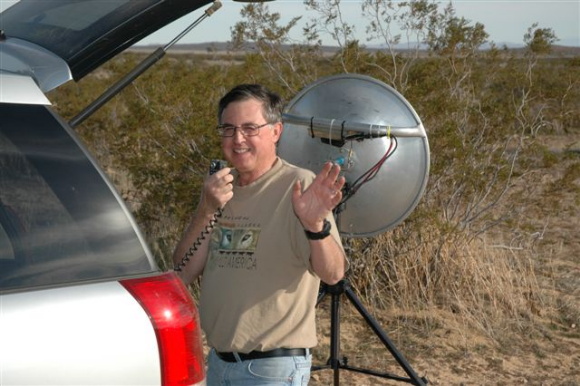
Here's Paul, N6DN, operating his 5.7 and 10 GHz system at the Mojave convergence
(photo by K6VCR)
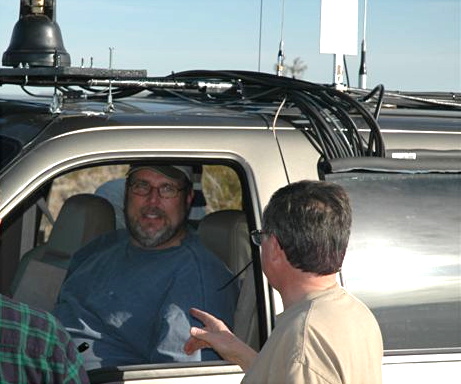
Dave, N6TEB talks with N6DN. Does Dave have enough coaxial cables
running into his car?
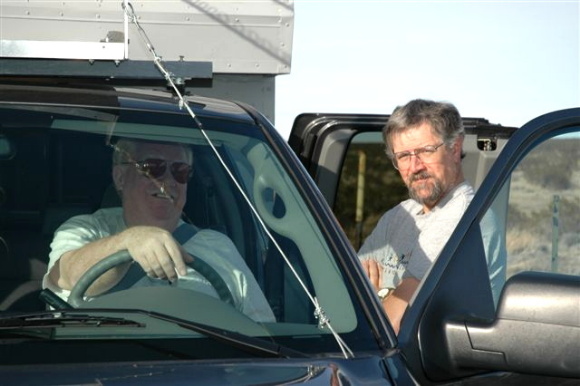
Rob Hughes, KG6TOA (left), who got his call sign specifically to take part
in roving expeditions, chats with his sports car rally buddy Hank Feilen.
They teamed up with K6VCR and N6MU, respectively. Both Tom and John
thought having a "designated driver" with credentials like that was a real
luxury.
January,
2007: An adventure with four rover stations
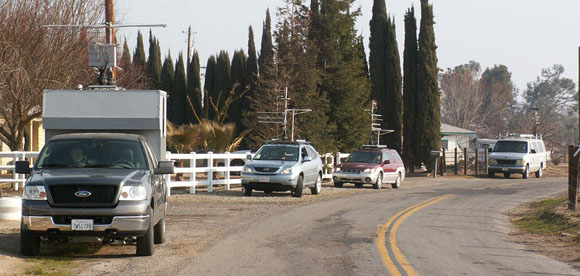
The rover expeditions kept growing in the 2000s. In January, 2007,
four stations traveled together from Orange County to Arbuckle, Calif.
for VHF SS. The group included K6MI and N6NB in the Ford F150 camper
(at left), W6YLZ in the Lexus RX-330, W6TE and WA6LUT in the Subaru Baja,
and KG6TOA and KI6AAY in the Ford E350 van, all shown here at the Madera
convergence. By then N6NB had added a new flagship station in the
F150 that housed kilowatt amplifiers on six and two meters capable of full
power while mobile in motion. That station also included amplifiers
capable of about 20 watts output on all the microwave bands. The
homemade camper attracted a lot of attention, some of it unwanted.
It was eventually replaced with a less conspicuous (but also less roomy)
commercial truck camper with a heavy roof rack.
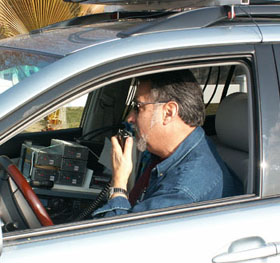
Miguel Ramirez, W6YLZ
|
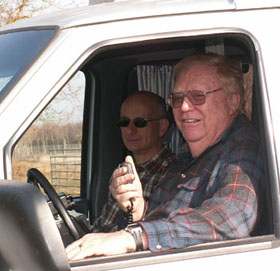
Bryan Sorensen, KI6AAY (in the passenger seat), and Rob Hughes, KG6TOA
|
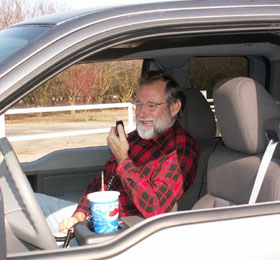
John Morrice, K6MI
|
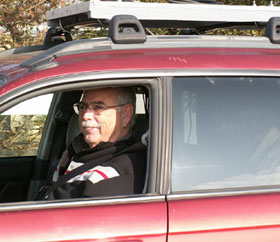
Dave Smith, W6TE, with Larry Bettencourt, WA6LUT, operating in back
|
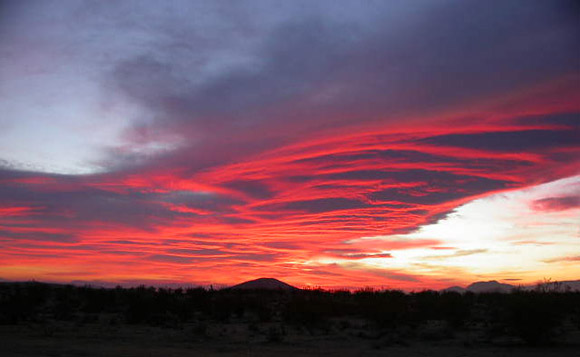
Here's another desert sunset, this one captured at the Mojave convergence
on Jan. 20, 2007 by W6YLZ, who managed to run up an impressive score operating
alone but also took time to notice and photograph the spectacular scenery.
September,
2007: the highest rover scores in that contest
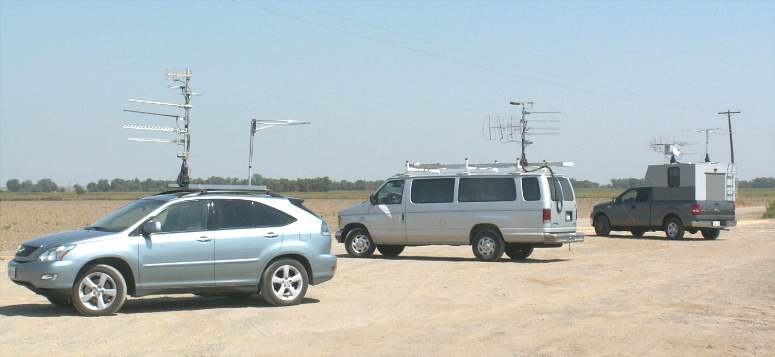
With a rule change imminent, we made an effort to achieve good scores
in what turned out to be the last contest under the 1995-2007 rule structure.
Once again we followed our California route to the Arbuckle convergence
northwest of Sacramento with three stations, activating 15 grid squares
and posting scores of over 600,000 points for a new record in the September
contest. This photo shows the group at the northwestern end of the
rove in CM89. The operators included K6MI and W6TE in the Lexus and
KK6KK and KG6TOA in the van, with N6MU joining N6NB in the F150.
January,
2009: Eight stations in the field
These rover expeditions have continued to grow as the rules evolved.
By January, 2009, we had eight complete 10-band stations available--and
all eight were on the road. W6TE (with WA6LUT part of the way) and
W6YLZ were in the unlimited category in which it's both acceptable and
practical to "grid circle." In the classic rover category, grid circling
is not a good strategy (with only a limited number of QSOs allowed with
any other rover, the savvy way to use those Qs is for multipliers--not
to work anyone more than once in a given grid square). We had four
rovers in the classic category: AF6O/R, KK6KK/R (with KG6TOA), N6NB/R
and W6XD/R (who was the top-scoring rover overall a year earlier in the
2008 VHF SS). This time we also had a talented newcomer in the limited
rover category: Carrie Tai, now W6TAI. So who was the eighth
rover? Well, N6TEB bought a new Ford diesel truck shortly before
the contest and borrowed one of the 10-band "toolbox" stations because
he hadn't yet had time to install his own excellent station in his new
truck. Dave met us at the Bissell (Mojave) convergence and worked
us on 10 bands there, but he did not travel on from there with us.
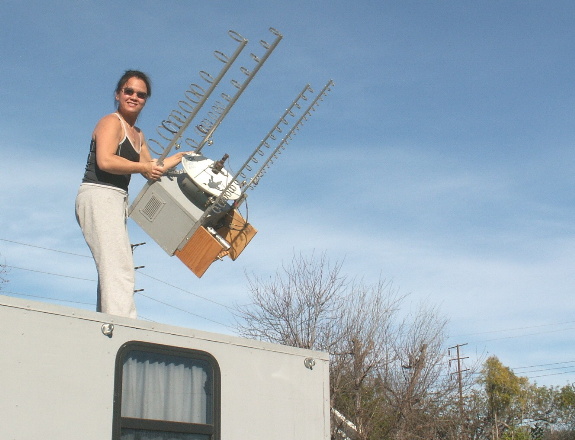
Before the contest, Carrie (W6TAI) hoists an equipment box and antenna
system atop a camper. This unit, which includes transverters and
amplifiers for four microwave bands as well as antennas for six bands,
weighs about 50 pounds, far more than you might suspect from the way she's
swinging it around.
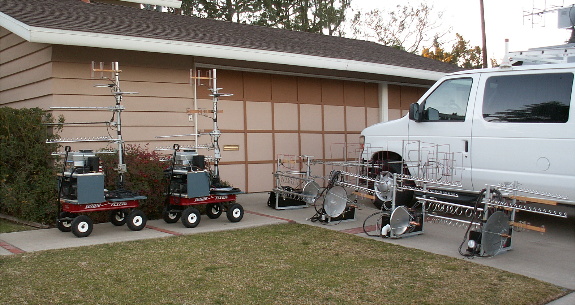
Here are eight 10-band VHF+ stations in one place. At left are the
original two rover stations, stored on red "Radio Flyer" wagons (of course).
They live in a storage building and are rolled out for mounting in/on a
vehicle. At right there are four "toolbox" stations, each containing
transverters (and in some cases, amplifiers) for all bands 902-10368 MHz.
Each can be mounted on a roof platform with a rotor or placed in a truck
bed for use. Each has a console with VHF+ transceivers, a rotor control
and the remote control unit for the toolbox. The console is typically
placed on the passenger seat for one-person operations. At right,
the van and truck (whose antennas are barely visible) house two more 10-band
stations. Altogether, there are 54 transverters and 24 transceivers
in the eight stations, with a number of amplifiers ranging in power from
a few watts on 10 GHz to full kilowatts on six and two meters.
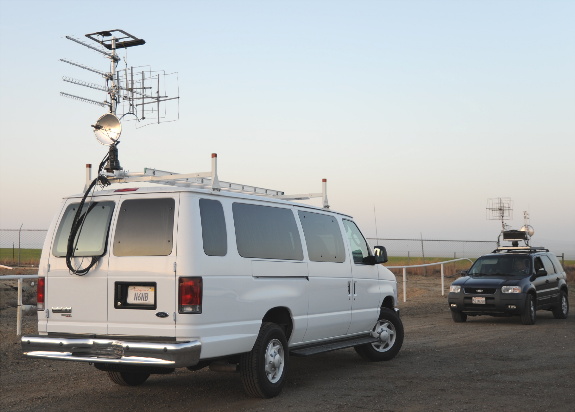
This Ford van is almost identical to the 1995 Ford van it replaces--except
that it had 137,000 fewer miles on it and it was 13 years newer.
It was the contest home of KK6KK and KG6TOA. Rob deserves an award
for driving the old van about 10,000 miles during previous contests.
At right is W6XD's Ford Escape, outfitted with a toolbox station for 10
bands.
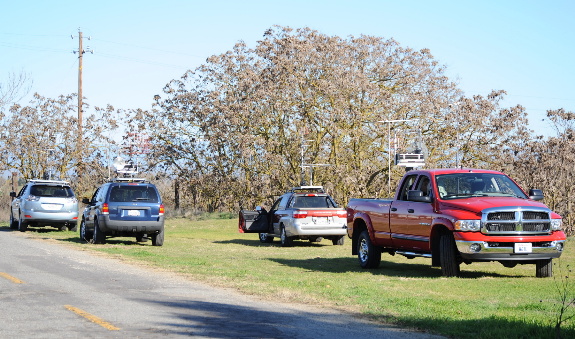
In this photo at the Madera convergence, the stations operated by (from
left) W6YLZ, W6XD, AF6O and W6TE are in view.

In this in-motion photo, taken by W6TAI from another car, N6NB/R operates
on 1296 MHz while driving about 60 mph. Um, maybe more than that...
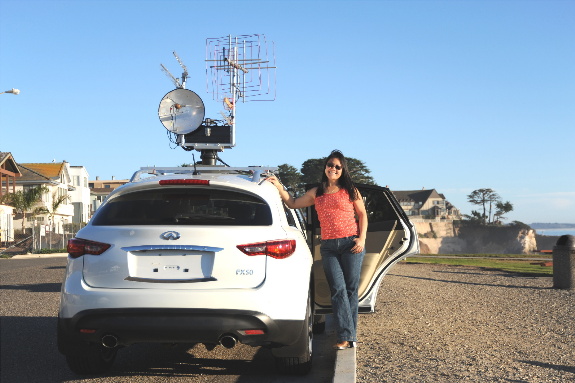
Carrie (W6TAI) poses with her rover setup in Shell Beach (CM95) the day
after the contest. She was first licensed as KI6UZV 12 days before
the contest and received her vanity call four days after the contest.
She drove and operated alone but had mentoring from several longtime radio
amateurs. None of them had ever seen a newcomer learn more quickly
how to operate a contest or aim a microwave dish to find weak signals.
She had the #1 score nationally in the limited rover category in January
'09, her first contest--and the last contest in which limited rovers could
operate on any four bands. Four months later, Carrie earned
her extra class license. Later she posted several more top scores
as a classic rover, including the #1 score in the country in June, 2010.
Carrie holds a graduate degree in urban planning and works in that field
when not pursuing amateur radio and a host of other avocations.
2009-2011:
As many as eleven (11) 10-band rovers in the club competition!
By Summer, 2009, we had enough hardware to
outfit eleven (yes, 11) vehicles as 10-band rover stations, and four other
members of our group (KE6HPZ, N6TEB, N6VI and W6TE) had built their own
10-band rovers. Several of us who have been longtime members of the
Southern California Contest Club decided to enter the newly announced club
competition in the August UHF Contest. We also submitted a club entry
under the SCCC banner in several more contests. The SCCC group had
the highest club aggregate scores in the country in August and September,
2009, and in January, June, August and September, 2010, and January, 2011.
No west coast club had ever had the top overall score in the club
competition in any VHF contest until the SCCC won these seven club gavels.
In addition to hardware, the SCCC has been
blessed with talented operators and leaders. Art Goddard, W6XD, has
become the group's field commander, functioning as a combination quarterback
and cat-herder. Marty Woll, N6VI, has brought an accountant's expertise
to the planning process, generating spreadsheets and documentation that
have been a key contributor to SCCC's success.
To compete as a club, the SCCC rovers had
to devise new routes that kept us entirely within the official boundaries
of the club, as required by the rules of the club competition. Each
participating club must designate a center point. Only members who
live within 175 miles of that point can compete for the club, and rovers
may not count any score achieved while operating outside this 175-mile
radius. There are elaborate rules governing participation by non-members
along with members. In general, a rover score may be counted by a
club if there are two operators and one is a resident club member.

Here are eight rover stations lined up during the August, 2009 UHF contest
for a photo opportunity near Palmdale, Calif. (from left): W6YLZ,
N6MU, AF6O, W6TAI, W6XD, N6NB, KK6KK (with KG6TOA) and W6TE (with K6MI).
In addition, several other stations joined in the SCCC club effort, including
some at home and others on DXpeditions to rare grid squares. To many
SCCC members, the idea of a DXpedition to San Diego (DM12) seemed preposterous,
but K6VCR's expeditions yielded 10 new multipliers for all of us, only
two or three of which we might have otherwise worked. N6TEB's expeditions
to Gaviota State Beach (CM94, west of Santa Barbara), produced many more
new multipliers and gave him a chance to give in-the-field contest experience
to a young ham couple: K6SVG and KI6PXI.
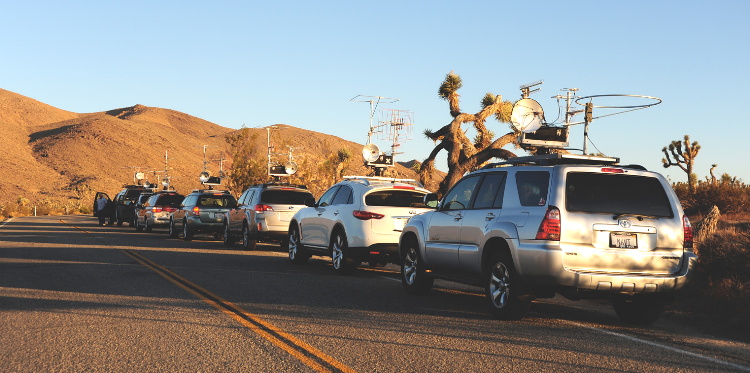
Seven rover stations line up for another photo opportunity, this time in
Joshua Tree National Park, with the bizarre shapes of the trees competing
with toolbox stations for visual drama. These seven were among nine
rovers who traveled together for at least part of the September, 2009 VHF
contest. This photo was taken in the rare grid of DM23 just before
the end of the contest. N6VI's 4Runner is in the foreground at right.
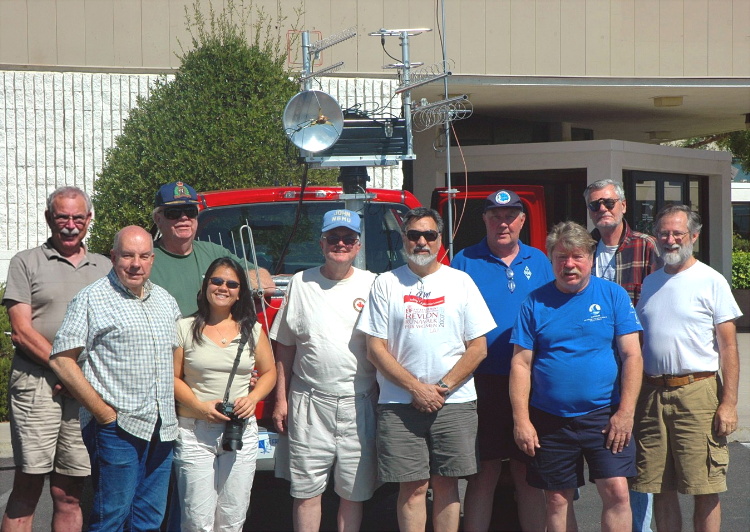
This photo was taken at the end of the August, 2009 UHF contest in Pahrump,
NV (DM26). From left: W6TE, N6NB, KG6TOA, W6TAI, N6MU, W6YLZ,
AF6O, KK6KK, W6XD and K6MI.
 In the January, 2010 VHF SS, this group gathered in the California desert
near the end of the contest. They are (from left): N6TEB, AF6O,
N6VI and KJ6CNO, W6XD (beyond Marty and Clara), N6NB, N6HC, KK6KK, K6WCI,
N6MU and K9JK. Not shown is W6TAI, who took the picture. JK
flew out from Illinois the join in the group rove.
In the January, 2010 VHF SS, this group gathered in the California desert
near the end of the contest. They are (from left): N6TEB, AF6O,
N6VI and KJ6CNO, W6XD (beyond Marty and Clara), N6NB, N6HC, KK6KK, K6WCI,
N6MU and K9JK. Not shown is W6TAI, who took the picture. JK
flew out from Illinois the join in the group rove.
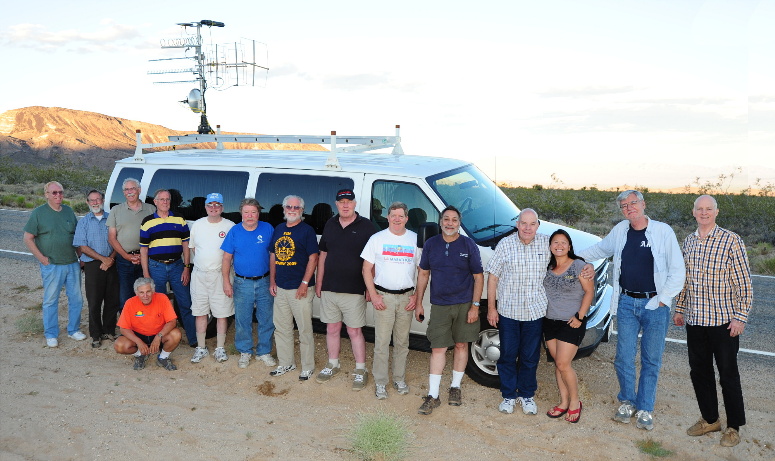 This group of 15 operators in 10 rover vehicles gathered in the eastern
Mojave Desert at the end of the June, 2010 VHF contest. They are
(from left): KG6TOA, K6MI, W6TE, W6KYO (kneeling), NI6E, N6MU, KK6KK,
N6HC, AF6O, N6VI, W6YLZ, N6NB, W6TAI, W6XD and K6ZMW. One of the
highlights of this contest was that Carrie (W6TAI) had the highest rover
score in the country. That is surely a first for a YL driving and
operating alone as opposed to operating as part of a two-person team.
During this contest N6TEB's multioperator group operated at the N6NB cabin
at 6,800' elevation in the Tehachapi Mountains and posted the highest west
coast multioperator score in many years. Their 11-band station (including
24 GHz) had a big signal everywhere we went. WB2WIK guest-operated
the new 10-band N6NB home station in the flatlands of DM13 and had the
highest single operator low power score on the west coast.
This group of 15 operators in 10 rover vehicles gathered in the eastern
Mojave Desert at the end of the June, 2010 VHF contest. They are
(from left): KG6TOA, K6MI, W6TE, W6KYO (kneeling), NI6E, N6MU, KK6KK,
N6HC, AF6O, N6VI, W6YLZ, N6NB, W6TAI, W6XD and K6ZMW. One of the
highlights of this contest was that Carrie (W6TAI) had the highest rover
score in the country. That is surely a first for a YL driving and
operating alone as opposed to operating as part of a two-person team.
During this contest N6TEB's multioperator group operated at the N6NB cabin
at 6,800' elevation in the Tehachapi Mountains and posted the highest west
coast multioperator score in many years. Their 11-band station (including
24 GHz) had a big signal everywhere we went. WB2WIK guest-operated
the new 10-band N6NB home station in the flatlands of DM13 and had the
highest single operator low power score on the west coast.
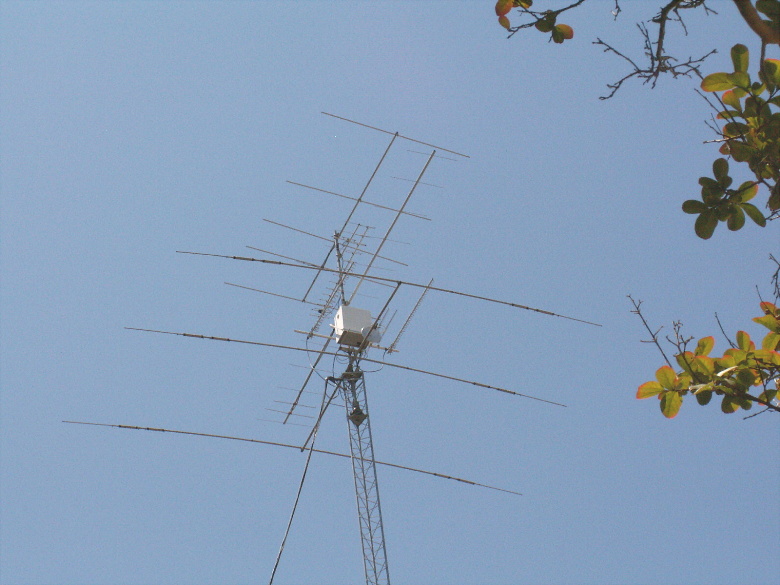
A noteworthy thing about the August, 2010 UHF contest was WB2WIK's
national first place score in the single operator low power category.
Steve guest-operated N6NB's home station in DM13. The 70-foot tower,
with antennas for all bands from 14 MHz to 10 GHz, is shown above.
It was the first time since the late 1970s that any west coast fixed station
had been #1 nationally in the UHF contest. (N6NB, operating fixed
atop Mt. Pinos, won the first two UHF contests in 1978 and 1979).
August 2010 was also a very successful contest for the SCCC rovers.
N6NB and W6TAI both broke the rover scoring record and W6YLZ finished #1
nationally in the limited rover category.
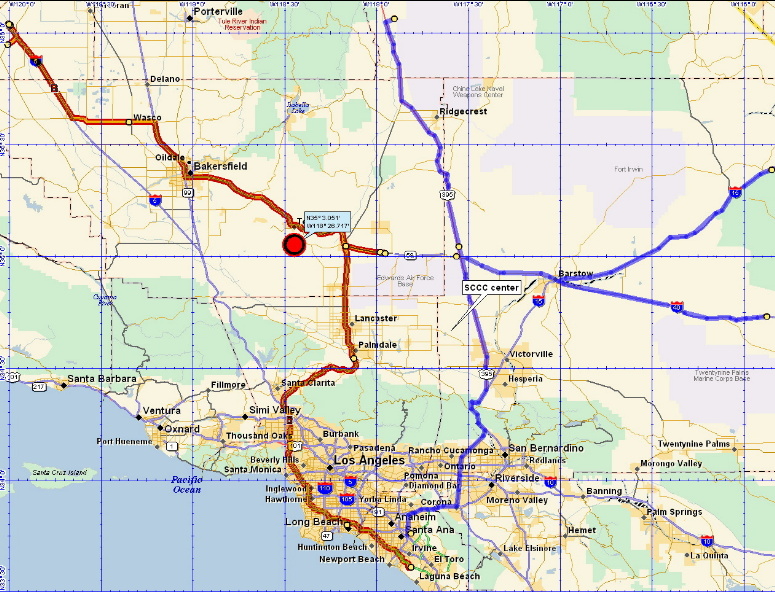
This map shows some relevant locations for the Southern California
Contest Club rovers during the September, 2010 VHF contest. The club
center is marked by a tag near the middle of this image. The main
group of eight rovers followed the route in orange and red, starting at
Signal Peak in Orange County (DM13) and ending near Kettleman City (CM96)
after activating nine grids. The route of W6TAI, who roved alone,
is shown in blue. Carrie went on a 10-band DXpedition to three very
rare grid squares: DM16, DM25 and DM24. Meanwhile, N6NB operated
fixed in the single operator (QRP) portable category at 6,800' elevation
on a road near the Tehachapi cabin (marked by a red dot). By working
the rover group on 10 bands in nine grid squares and by working W6TAI for
18 more multipliers in three other grid squares, N6NB was able to set a
new September scoring record of about 266K in the QRP category, breaking
a record of 171K set by K9PW 13 years earlier. The top rover score
in the country in this contest was posted by Bob Mann, KK6KK.
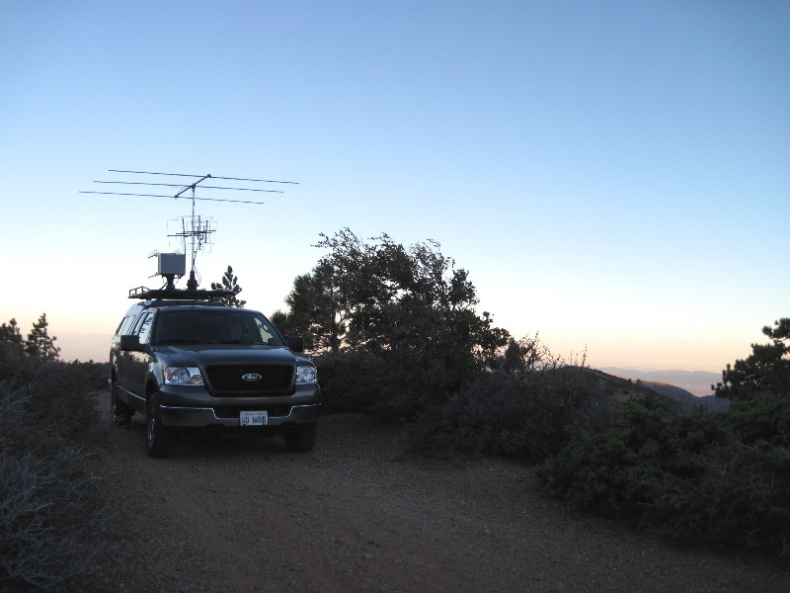
This station setup was used by N6NB in the single operator (QRP) portable
category in September, 2010. Because the antennas had to be installed
on site to avoid damage from low trees along the 10-mile dirt road up the
mountaintop, it made sense to use slightly larger antennas than in a typical
rover installation where the truck is driven with the antennas in place.
If you look beyond the mountain, you can see an inversion layer forming.
It resulted in good tropo conditions up the San Joaquin Valley late in
the contest, allowing N6NB to work some distant multipliers with 10 watts
that had been unworkable earlier in the weekend.
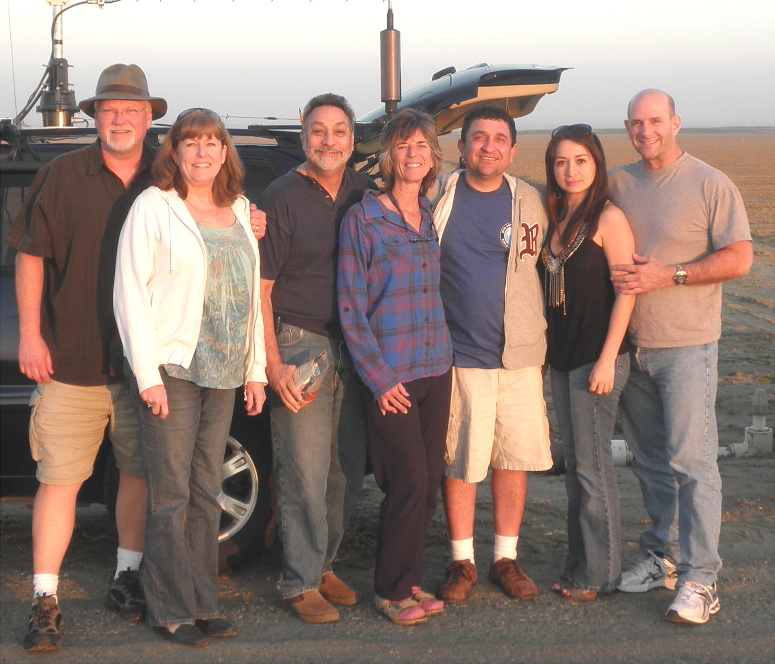
The January, 2011, VHF Sweepstakes was the first rove for several newcomers
to the SCCC group. This photo shows K6AH and his wife Sally (both
newcomers), W6YLZ (a veteran of many roves), N6UWW (on her second rove),
KG6OKB (on his first rove), and N6HD (right) with his friend Evelyn (on
their second rove). The photo was taken by WB6BFG (on his third rove).
Others roving with the group at least part of the weekend were longtime
rovers K9JK (+N6MU), KE6HPZ, N6HC, and N6TEB (+K6WCI). Of this group,
only three rovers were together all weekend. WB6BFG and N6UWW began
the contest in Del Mar Heights and quickly handed out the DM12 multiplier
on 10 bands before joining the group. This time most of the group
gathered at Signal Peak (DM13) at the start of the contest to work a contingent
from the San Diego Microwave Group who were atop Mt. Soledad (DM12).
The San Diego group included KB5MU, KD0IF, N6IZW, W5NYV and W6OYJ.
Thanks to them for so many microwave Qs! When the results were compiled
and published in QST, K9JK and N6MU had the top rover score in the country,
followed closely by K6AH. KE6HPZ won the unlimited rover category
and W6YLZ was again #1 in the limited rover category.
N6NB broke the January single op portable scoring record.
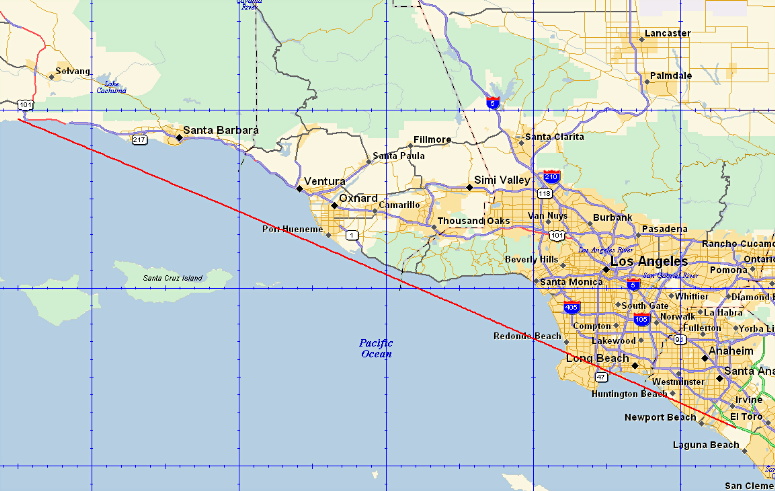
A highlight of January, 2011 was a DXpedition to CM94 by W6TAI/R, who
provided 10 rare band-multipliers to the rovers as well as N6NB (in the
single operator portable category). This photo shows the 152-mile
path from Signal Peak in DM13 to Carrie's site on a bluff near Gaviota
State Beach. As the Hepburn forecast had predicted, there was just
enough over-water tropo to make this possible.
In June, 2011, the SCCC rovers visited 10
grid squares within club territory, with K6MI the national winner of the
rover category, just ahead of K6AH. A highlight was the debut of
Art Goddard's daughter Amy, W6XDX, as a full weekend rover in a father-daughter
team. K6GEP joined the group for part of the weekend, as did N6HC
and N6NC. Meanwhile, W6TAI went on a solo rove to 10 grid squares
on her own, covering 873 miles and providing many multipliers to the rover
team and others, including the N6VI multioperator group on Frazier
Mountain and N6NB, again in the single operator QRP portable category.
The map immediately below shows the microwave paths over which N6NB worked
the rover group or W6TAI in an effort that led to a third national record
score in the QRP portable category, this time with a score of 295K.
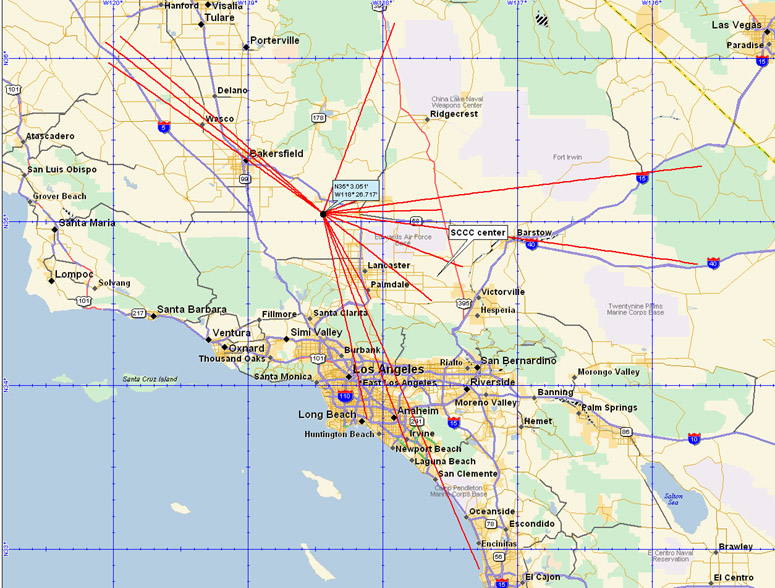
January,
2012: the East Texas roving adventure

This photo, taken just before the start of the January, 2012, VHF Sweepstakes,
shows eight rovers near Port Arthur, TX in EL39. This group included
10 members of the Nacogdoches (TX) Amateur Radio Club and five visitors.
For some years we have been watching the VHF
contest successes of the Nacogdoches Amateur Radio Club. Despite
being in a town of only 33,000 people nowhere near any big city, this club
has been turning in impressive scores year after year.
After talking with Army Curtis, AE5P, and
Marshall Williams, K5QE, at the 2011 Central States VHF Conference in Dallas,
several of us accepted their invitation to join them for a VHF contest
in East Texas. Six Californians traveled there. Five of us
roved with Nacogdoches club members, using their call signs and helping
out wherever we could. The sixth visitor (W6XD) joined the team at
K5QE's well-equipped multioperator station.
We were amazed by what we saw. This
small club had more than 20 members active in VHF SS, including about 15
who roved and five who operated at K5QE. Several others got on at
home. We met some wonderfully dedicated and conscientious people
during our week in Nacogdoches. We hope to stay in touch with them
for the rest of our days in amateur radio. We are very grateful for their
hospitality.
It was a banner year for the Nacogdoches club,
the rovers and K5QE. The club, moving up from the local club category
to "Division I-A," had the highest club aggregate score in the country.
Nacogdoches had the top seven rover scores, and K5QE had the highest multioperator
score anywhere.
Even the weather was perfect--with temperatures
in the 70s, no rain, and evenings warm enough for outdoor station-building.
It was a memorable experience.
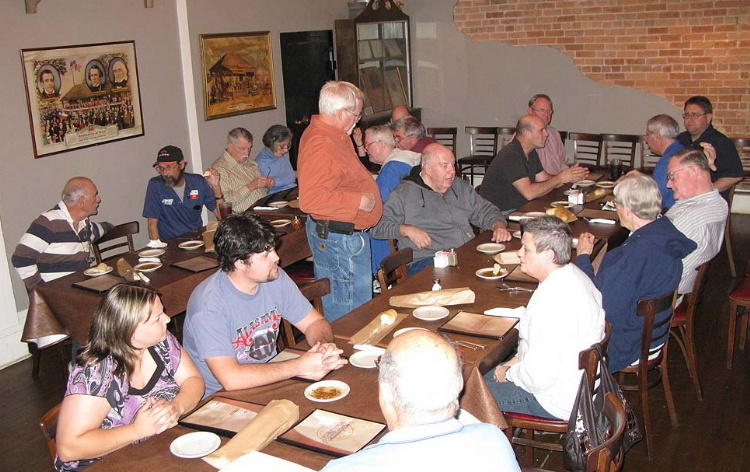
Photo by W6XD
This group, which included almost the entire K5QE multioperator team and
many of the Nacogdoches rovers, gathered for dinner on the Friday night
before the January, 2012, VHF contest. It was a chance to meet and
greet--and a time to plan for what turned out to be a very successful contest
for K5QE, the Nacogdoches club and the rovers.
More
2012-13 results
After the 2012 East Texas adventure, the Southern
California Contest Club sent smaller roving groups afield for the June
and August, 2012 VHF/UHF contests. In June, the club's rovers had
the top six rover scores nationally, led by the two-person team of W6XD/R
and AE6Z with 272,500 points. Close behind were KI6FGV/R, K6AH/R,
N6HD/R, the team of WA6WTF/R and W6TE, and K9AOG/R. N6NB led the
single operator portable category nationally with 136,840 points.
In the very competitive multioperator category, N6VI was fifth nationally
with 509,922 points.
In the August UHF contest, only four SCCC
rovers ventured out, but they finished 1-2-3-4 in the country. N6NB/R
won, with W6XD/R a close second, W6TAI/R third and N6EY/R (paired with
W6TE) fourth. At the last minute, N6MU agreed to get on for a few
hours at N6NB's home station--and he had the top single operator, low power
score on the west coast, while the club won another gavel.
In January, 2013, N6NB and W6TAI joined a
small group of rovers in East Texas. Perhaps the highlight was the
first use in a contest of the tower trailer built from a kit (described
elsewhere
on this website). The photo below shows the tower raised about
halfway beside a hotel in the town of Center, TX (EM21). The tower
trailer proved its worth by making it possible to work K5QE on all bands
through 10 GHz in six grid squares, even in places where other rovers could
not get through because of trees and buildings in the near field.
The tower trailer was set up 10 times over two days in a rove that began
near Port Arthur, TX and ended in northern Louisiana. N6NB and W6TAI finished
first and second nationally in the rover category.
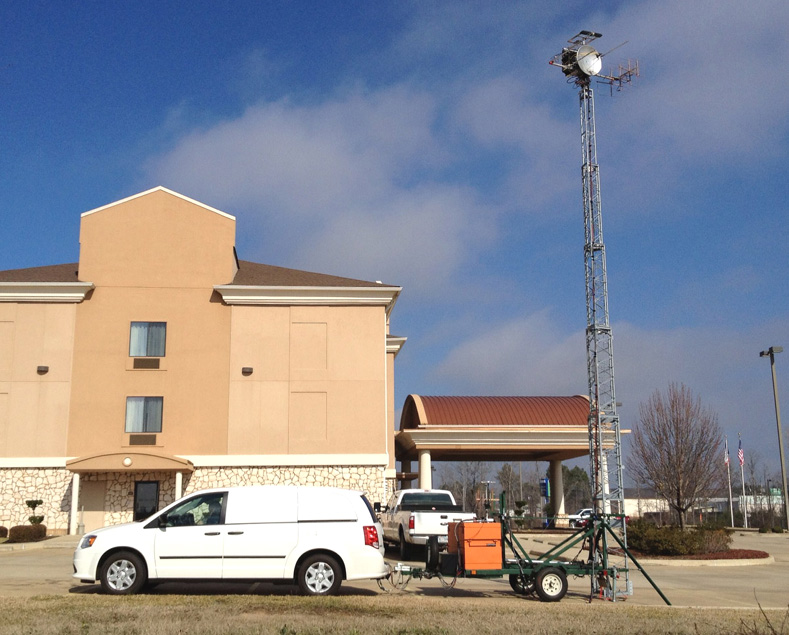
This is N6NB's new rover van and tower trailer, shown with the tower
extended about halfway. This setup was built in California during
2012 and driven as far as Cape Cod, MA before being returned to Texas for
the January contest. In a way, this was reminiscent of the late 1970s,
when N6NB towed a tower trailer from California to Vermont for VHF contests.
Of course, that tower trailer was only set up once for each contest because
there was no rover category then. N6NB was competing in the single
operator category in the 1970s. The photo below shows the new tower
trailer back home in Southern California for a single operator QRP portable
effort in the June, 2013 VHF contest. The photo was taken just as
the fog burned off at Signal Peak, a hilltop in Newport Beach, CA.
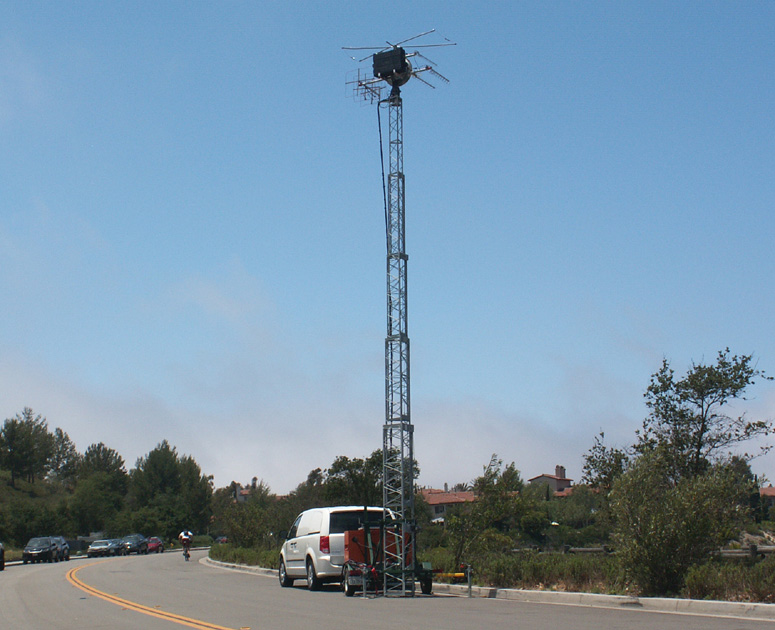
The June, 2013 VHF Contest was a good one for
the Southern California Contest Club, which won another club gavel--but
just barely. SCCC had a club aggregate score of 1.36 million points.
The Potomac Valley Radio Club had 1.33 million points. In the individual
results, four SCCC members placed in the top five in the rover category.
K6AH was first, KI6FGV (now K6FGV) was second, N6HD was third and KJ5MSY
was #5 overall. In the very competitive multi-multi category, N6VI
was #3 nationally. It was the first time in many years that a west
coast multioperator station had fared that well nationally. W6TE
was #1 nationally in the unlimited rover category, and N6NB won the single
operator (QRP) portable category.
A small group of SCCC members
operated the August, 2013 UHF contest as rovers (see the photos below),
and they won another club gavel. N6NB finished first in the rover
category, followed by KI6FGV and the family duo of N6EY and N6KYS. Sharing
a station under the family rule for the first time (they were married three
weeks before the contest), Jason and Kris tied for third nationally. W6TTF
and WA6WTF tied for sixth.
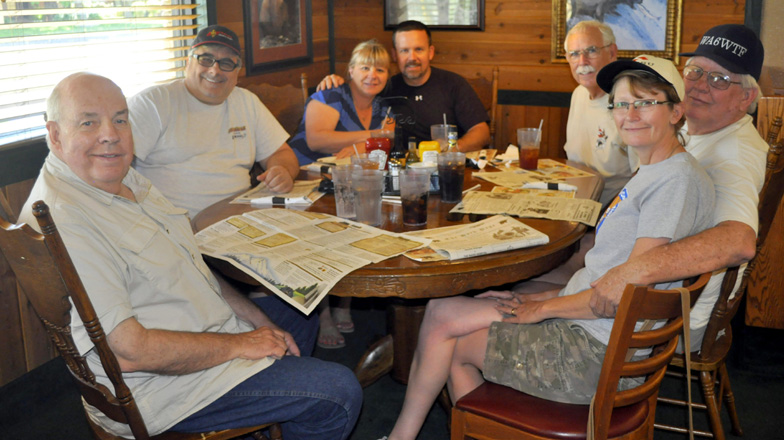
This group of rovers gathered for lunch during the 2013 UHF contest.
They are (from left): Wayne, N6NB; Jim, KI6FGV; Kris, N6KYS; Jason,
N6EY; Dave, W6TE; Carole, W6TTF; and Jan, WA6WTF. The group included
two couples: Kris and Jason Boyer (who had been married for all of
three weeks when they roved together) and Carole and Jan Whitteberry (who
had been married a little longer).
Certainly a highlight of the August, 2013
UHF Contest for the Southern California Contest Club was the extensive
use of 24 GHz--by women, as the photos below illustrate.
|
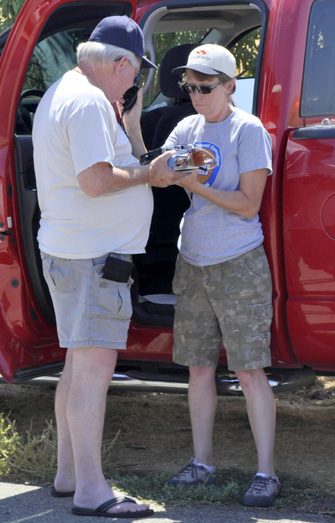 
Jan and Carole Whitteberry (WA6WTF and W6TTF) are the picture of concentration
as they make a contact on 24 GHz, while newlyweds Kris and Jason Boyer
(N6KYS and N6EY) observe the customs of chivalry--Jason holds the 24 GHz
transceiver while Kris makes a contact! Thanks to W6TE for these
photos. |
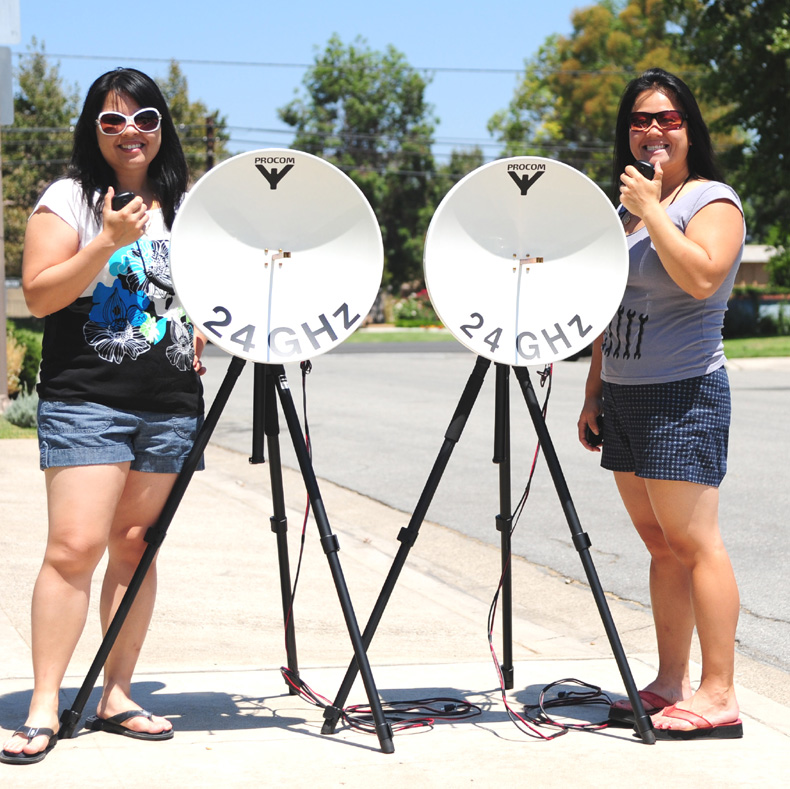
Here's Marie Tai (W1TAI, left, visiting from Boston, MA) with her sister
Carrie (W6TAI), posing with the high-performance 24 GHz systems that they
used during the 2013 UHF contest.

...And this is what happens when the Tai sisters make contacts on 24
GHz. Um, well, the truth is that this photo was staged after the
contest, but anyone can see their unbridled enthusiasm for 24 GHz!
During the September, 2013 VHF contest, seven
rovers were in the field for the Southern California Contest Club--AF6O,
K6AH, K6FGV, KJ6CNO, N6HD, N6VI and W6TAI. K6FGV was #1 nationallly,
with K6AH a close second, reversing their order of finish the previous
June. N6VI was third and N6HD fourth, with AF6O seventh. Carrie,
W6TAI, went to Gaviota, about 30 miles west of Santa Barbara in the rare
grid square of CM94. She worked the other rovers on all bands through
10 GHz over a 150-mile path down the California Coastline in DM13.
Meanwhile, W6TE and K6MI were a two-person multioperator group on Frazier
Mountain (DM04), setting a new Southwestern Division record and finishing
#5 nationally in the highly competitive multi-multi category. I (N6NB)
won the single operator (QRP) portable category, also setting a new Southwestern
Division record. I set up in the driveway of a vacant house in Panorama
Heights, east of the town of Orange, CA. There was no permanent amateur
radio station there, thus qualifying the site for the SO portable category.
I used a small Honda generator beside the house both days and ran on the
batteries in my minivan at night, complying with the portable power requirement.
Remarkably, the neighbors didn't complain about the generator or the tower
trailer in the driveway, and both were gone by the Monday after the contest.
But the neighbors may see more antennas later (I now own that house).
The photo below shows the tower trailer in the driveway at Panorama Heights.


This is the view from the Panorama Heights house, looking northwest
toward Los Angeles.
A
final note
By 2014, most of the group that did these roving adventures was, well,
not young any longer. Several of the key players had observed their
70th birthdays, with others soon to follow. Sadly, three of the rovers
shown on these pages have passed away (see below). Perhaps the Southern
California Contest Club will not again mount a roving effort as large as
the biggest ones in 2009, 2010 and 2011. But we have a lot of good
memories of the times we shared--and we had 10 club gavels as of 2014.
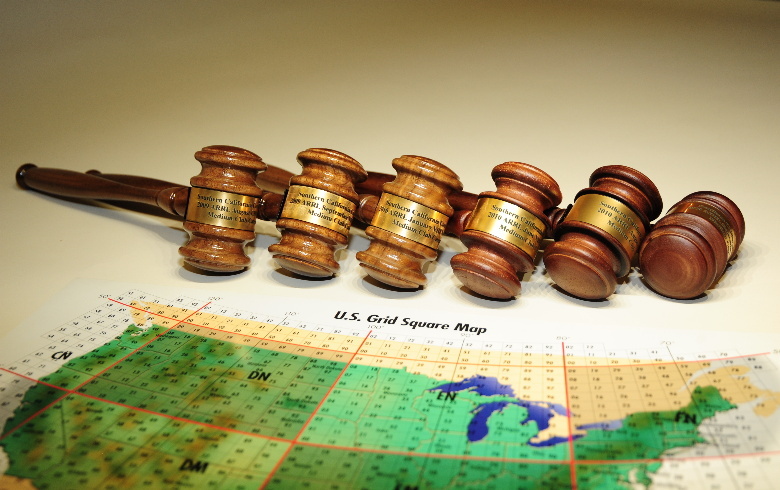
Here are six of the seven gavels won by the Southern California Contest
Club in VHF contests between 2009 and 2011. Eastern clubs have won
far more of these in VHF contests--the Mt. Airy VHF Club in Pennsylvania
has more than 50 gavels in its collection. But no west coast club
had managed to win even one gavel in a VHF contest until recently.
A postscript: Phil Goetz, N6ZZ, one of
the world's most respected contesters, passed away in early 2007, barely
two years after his two-million-point rover expedition in Texas and New
Mexico. Bob Mann, KK6KK, passed away in February, 2011.
He was the #1 rover in the country during his last VHF contest (September,
2010). John Zapisek, K2MM, passed away in August, 2012.
One of JZap's previous call signs, WA1MUG, became famous when it was used
by the Mount Greylock contest group before the group adopted W2SZ, the
club call sign of Rensselaer Polytechnic Institute. On a happier
note, Marty Woll, N6VI, went on to become the vice director
of the ARRL Southwestern Division in 2008. Art Goddard,
W6XD, published a book on the history of Costa Mesa with his wife,
Mary Ellen, and is now doing speaking engagements and book signings as
an author. Carrie Tai, W6TAI, moved from technician to general and
then on to an amateur extra class license in the four months following
her January, 2009 debut in amateur radio. Dave Smith, W6TE, headed
up the Echoes of Apollo celebration to mark the 40th anniversary
of the 1969 lunar landing by activating the 150-foot Stanford dish on 1296
MHz e.m.e.
-Compiled by Wayne Overbeck, N6NB
<return to N6NB page>
|





 The rover scoring system has also been controversial. The system
has been revised four times, and some rovers are still not pleased with
the result. Originally, rover stations scored their activity
in each grid square separately. For a time QST magazine listed
all of these separate scores and didn't separate out rovers from single
operators. The separate scores were very low compared to single operator
scores, even if all of a station's scores were added up. Rovers demanded
better treatment. The response was a rover scoring system, introduced
in 1991, that some have called "megascoring." The contacts and multipliers
from all locations were aggregated and the sums were then multiplied, producing
much larger total scores. Even though that produced an enormous increase
in rover activity, the higher scores stirred controversy, too.
The rover scoring system has also been controversial. The system
has been revised four times, and some rovers are still not pleased with
the result. Originally, rover stations scored their activity
in each grid square separately. For a time QST magazine listed
all of these separate scores and didn't separate out rovers from single
operators. The separate scores were very low compared to single operator
scores, even if all of a station's scores were added up. Rovers demanded
better treatment. The response was a rover scoring system, introduced
in 1991, that some have called "megascoring." The contacts and multipliers
from all locations were aggregated and the sums were then multiplied, producing
much larger total scores. Even though that produced an enormous increase
in rover activity, the higher scores stirred controversy, too.
 After several years, ARRL reached a compromise: rovers could continue
to aggregate their QSO points, but they could count each multiplier only
once--with a single additional multiplier for each grid square activated.
This resulted in rover scores somewhat more comparable to those attainable
by fixed stations. However, it became clear over the years that rovers
can still achieve high scores, especially when two or more rovers travel
together so they all can work the rare multipliers that they are handing
out to others. By roving in tandem and sometimes circling a four-grid
convergence, rovers can amass scores that only the top fixed single-operator
stations can match. This has enabled some rovers to achieve high
scores even in sparsely populated areas where there may be no fixed stations.
After several years, ARRL reached a compromise: rovers could continue
to aggregate their QSO points, but they could count each multiplier only
once--with a single additional multiplier for each grid square activated.
This resulted in rover scores somewhat more comparable to those attainable
by fixed stations. However, it became clear over the years that rovers
can still achieve high scores, especially when two or more rovers travel
together so they all can work the rare multipliers that they are handing
out to others. By roving in tandem and sometimes circling a four-grid
convergence, rovers can amass scores that only the top fixed single-operator
stations can match. This has enabled some rovers to achieve high
scores even in sparsely populated areas where there may be no fixed stations.
 The second rover station, used during the early and mid-2000s, utilized
a Ford E350 15-passenger Supervan with all but the front seats removed.
Its antenna system was similar to the one on the Isuzu but with a longer
mast to take advantage of the greater length of the van. That permitted
excellent separation between antennas for various bands, minimizing interaction.
This rover station made its debut during the 2003 January VHF SS contest
on
the east coast. The van was driven from California to the northeast
and back just for the contest--a 6,500-mile trip that may rank as the longest
roving expedition ever in total miles driven to rove in a VHF contest.
In the photo here, the van is shown at an overlook on Interstate 80 near
Hackettstown in western New Jersey (FN20). Was it worth a 6,500-mile
trip? Any dedicated amateur radio contester knows the answer to that
question! It was also a sentimental journey--N6NB/1 on Mt. Equinox,
VT, set national scoring records in the June and September VHF contests
as a single operator in 1979-1980.
The second rover station, used during the early and mid-2000s, utilized
a Ford E350 15-passenger Supervan with all but the front seats removed.
Its antenna system was similar to the one on the Isuzu but with a longer
mast to take advantage of the greater length of the van. That permitted
excellent separation between antennas for various bands, minimizing interaction.
This rover station made its debut during the 2003 January VHF SS contest
on
the east coast. The van was driven from California to the northeast
and back just for the contest--a 6,500-mile trip that may rank as the longest
roving expedition ever in total miles driven to rove in a VHF contest.
In the photo here, the van is shown at an overlook on Interstate 80 near
Hackettstown in western New Jersey (FN20). Was it worth a 6,500-mile
trip? Any dedicated amateur radio contester knows the answer to that
question! It was also a sentimental journey--N6NB/1 on Mt. Equinox,
VT, set national scoring records in the June and September VHF contests
as a single operator in 1979-1980.




















































